Your guide to avoiding hair loss from manbuns and topknots
Lately and with the advent of the man bun hairstyle as the most-popular long hairstyle trend in 2015, we have been getting more men with hair loss issues coming to our hair salon and asking about how to grow a man bun with male patter baldness. Usually, it isn’t a question of “how to grow a man bun” but “whether you should be growing a man bun in the first place” if you’re already balding or if you intend to keep your long mane (and its hairline) healthy for the many years to come.
In a way, It does seem as though almost every male here in the United States under the age of 35 is obsessed with the man bun hairstyle, and sometimes the mere desire to follow a trend (in this case, a hairstyle trend) can take over one’s own common sense despite the grave negative consequences of following some trends. Allow me to explain this in more detail below.
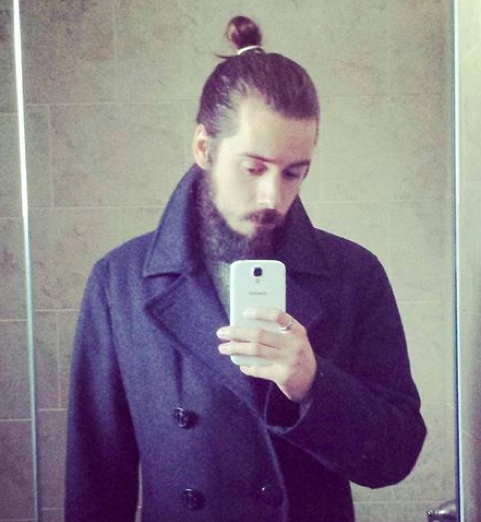
Male pattern baldness and the man bun
Male pattern baldness is the name for the type of hair loss most commonly experienced by men. It strikes in one’s thirties (usually) and the first usual symptom of male pattern baldness is a receding hairline at the forehead. The hair on the temples of the head (i.e. the corners of the forehead) starts to fall off and thin out, giving an appearance of a receded hairline). Eventually, the hair loss continues its backward progression until no hair is left on the top of the head. The loss of hair in male pattern baldness is irreversible and, to date, there’s no cure or permanent solution for male pattern baldness.
Male pattern baldness is usually measured with a progression scale known as the Norwood scale (or Norton-Hamilton scale), which measures the progression of male pattern baldness through 7 sequential stages. Here’s the diagram depicting the Norwood scale with its 7 stages of male hair loss:
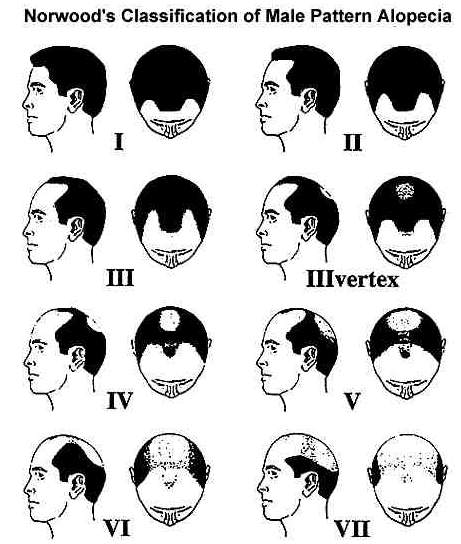
One of the overall effects of male pattern baldness is the progressive weakening and miniaturization of the follicles of the scalp. What this means is that the follicles (the tiny pockets that hair grows from) becomes weaker and weaker and its ability to hold and stabilize the follicle’s growing hair strand decreases substantially. All in all, this means that, in male pattern baldness, it’s extremely easy to rip out your own hair by simply combing it or pulling it; this is where the man bun poses a big problem.
Weaker follicles from tying a man bun or a top knot
The constant tension on your hair follicles from tying a trendy man bun or a top knot will weaken your follicles and the shaft (i.e. the structure) of the hair itself. As the follicles weaken, it is easier for the hair to break or to be ripped out of the follicle’s cavity; the hair loss that occurs from using a man bun or a top knot is known as traction alopecia. Unfortunately, traction alopecia is many times irreversible, and we’re seeing at our hair salon more and more guys with receded hairlines from wearing manbuns and topknots. I’m not kidding; we’ve seeing this since 2014, which is about a year after these bun hairstyles became immensely popular (i.e. 2013). In other words, after a year of wearing a tight top knot or a tight man bun, you can expect your hairline to be damaged and receded or shaped awkwardly.
Here’s a hair-salon example of a customer who had been wearing a man bun for way over a year. Pay special attention as to how his hairline has receded over an inch in length while some hair strands from his original hairline still remain (miraculously) intact, making way for an awkwardly-shaped hairline. By the way, kudos to the website ManBunHairstyle.net from bringing attention online to the issue of traction alopecia caused by man buns and top knots. They are the internet’s resource for man buns and they’ve reported the same negative consequences of these bun hairstyles that we too are seeing at our hair salon.
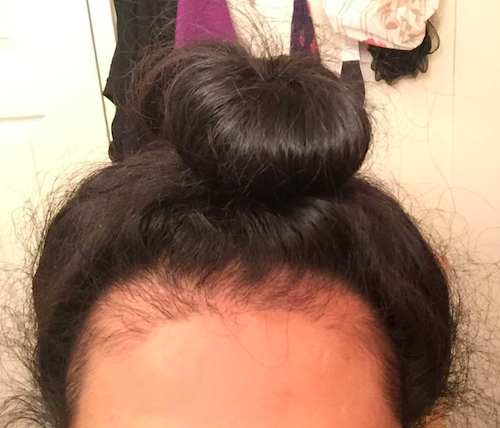
Balding men and getting a man bun
Going from the above, it’s important to outline that any guy with male pattern baldness must stay away from wearing man buns and top knots! The hair on the top of the head is already weakened, especially the hair around the forehead’s hairline, so tying either a man bun or a top knot will accelerate the balding process and make the hairline asymmetric as the pulling tension in these trendy bun styles is usually spread unevenly on the scalp.
We’re seeing men of all ages coming to our hair salon with destroyed hairlines caused by man buns and top knots, and even guys in their late teens and early twenties are coming in desperate to regain their once-smooth hairline. Here’s another example of a young male with a receding hairline caused by his use of the top knot hairstyle. In this case, he also suffers from male pattern baldness; thus making his use of the top knot a very bad decision since the top knot will compound his balding issues.
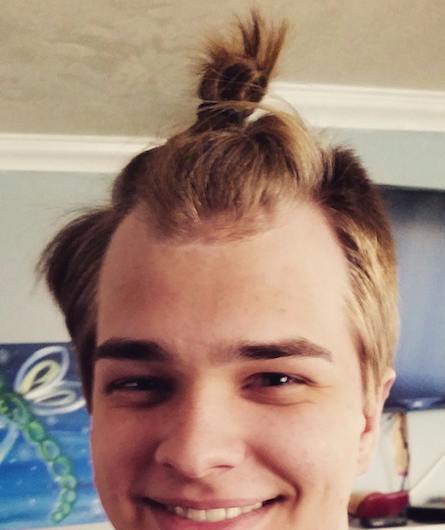
Lastly, avoid braiding your hair or putting it into cornrows. Sure, the manbraid hairstyle is becoming more popular in 2015 and will continue to remain popular in 2016, but the manbraid hairstyle will have you ripping out hair strands with the slightest movement of the bun. It’s not worth it, and a braided man bun or a braided top knot (i.e. a manbraid) only looks good on young guys with a head full of hair, so why risk your hair’s health when a regular man bun will look great on most guys anyway?
Two in-your-face examples of traction alopecia from wearing man buns
To illustrate how much damage can a tightly-tied man bun (or top knot) exert on a male’s hairline, I’m posting below the pictures of two French-Arab brothers who grew their hair long 18 months ago at the same time so as to wear tight man buns as part of their hipster look. One of the brothers suffers from male pattern baldness (first picture) while the other brother doesn’t suffer from male pattern baldness (second picture). At the start of their hair-growing journeys (i.e. no manbuns yet), the first brother had a slightly receded hairline (Norwood II stage) while the second brother had a healthy non-receding hairline.
Here’s the picture of the first brother; notice how receded his hairline is. There is the classic “hair isle” on the middle of his forehead, denoting some exceptional traction alopecia and an enhanced balding process.

Here’s the picture of the second brother. He doesn’t suffer from traction alopecia, but notice how his hairline has receded into a pseudo-Norwood III hairline. All of this from tying a tight man bun and wearing it 24/7, which is exactly what you should not do if you want to wear a man bun!

Here’s a picture of the two brothers together so that you can compare their hairlines.

How to avoid traction alopecia from a man bun or a top knot
For those of you guys who are balding (i.e. male pattern baldness), the solution is easy: do not wear a man bun or a top knot. You’re simply risking the absolute obliteration of your hairline if you’re balding already and decide to tie a bun or knot on your head. The picture above of the first depicted brother should give you a pretty good idea of how bad your male pattern baldness can go if you add a man bun into the equation.
If you’re balding and you still want to go ahead and wear a man bun, then I strongly recommend that you tie a loose bun and never tie your manbun tightly! To leave your man bun loosely tied, simply pull the tied hair from the forelock against the direction of the bun itself. This will release much of the tension placed on the hair strands of your forehead’s hairline that are tied into the bun. Furthermore, the minimum hair length of the man bun for balding men is twelve inches of length. This means that top knots are out for balding men, as the minimum hair length for a top knot is six inches and you will completely destroy your hairline with such a length of hair when tied as a topknot.
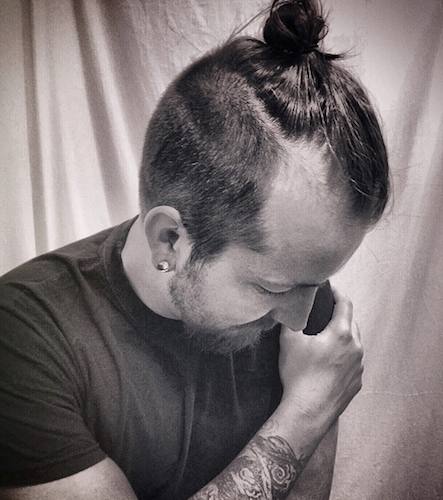
For those of you dudes with a healthy head of hair (i.e. you’re not balding), then I strongly recommend that you still follow the advice that I’ve given out in the previous paragraph. Even if you fancy tying a top knot, try to release some pulling tension from the hair located on your forehead’s hairline. I know, I know… the top knot hairstyle looks its best when it is tied extremely tight, but it’s in your best interest to take care of your hair as you don’t want to join the legion of devastated guys who are coming in to hair salons and barbershops worldwide (including ours) with destroyed hairlines from wearing tight man buns and top knots. Trust me on this one.
Taking the advice above to its full extent, if you want to have long hair and a bun hairstyle, yet you’d like to keep your hairline and hair health in check, you’d avoid this (i.e. top knot hairstyles):
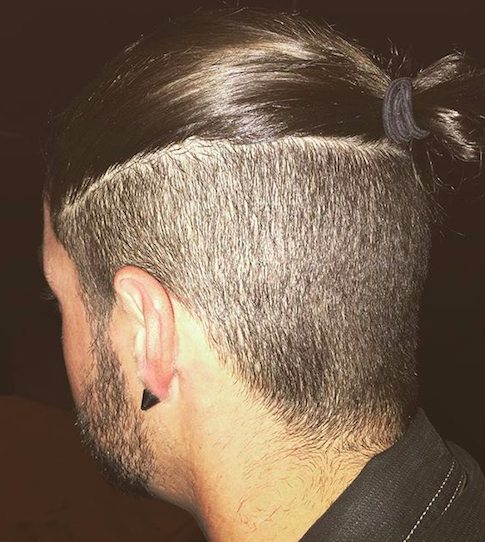
And, instead, you’d be getting this (i.e. loose man-bun styles):
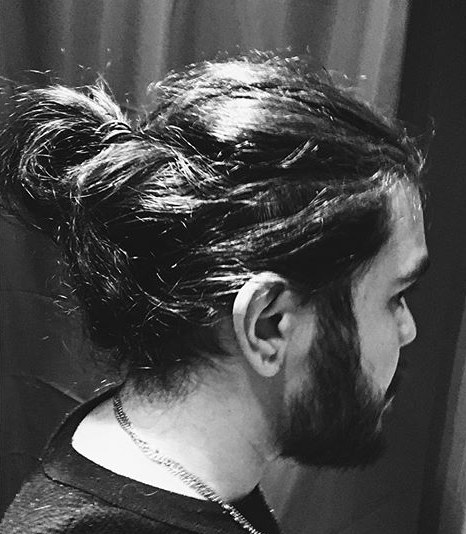
Another precaution to take when it comes to the man bun or top knot is to not wear these hairstyles every day. Allow your follicles to rest every couple days by leaving your long hair to hang down and dangle; don’t even tie your hair into a ponytail during those “rest” days. From my experience, give your hair follicles a break from your man bun or top knot every two days. Yes, I know that this sounds too frequent, but there are dozens and dozens of other hairstyles that you can go for as detailed in my long hairstyles guide and which will amplify your range of daily long hairstyles to choose from. There’s another world out there from the man bun, you know?
So, fellow long-haired readers, enjoy you man buns and top knots if you so wish to, but make sure that you take the necessary precautions as explained in this guide, as otherwise you will end up like the many man-bun-wearing guys that we’re starting to see at our hair salon with destroyed hairlines, and the prognosis and recovery in these cases are usually pretty bad.
Any questions? Then let them know below in the comments section.
